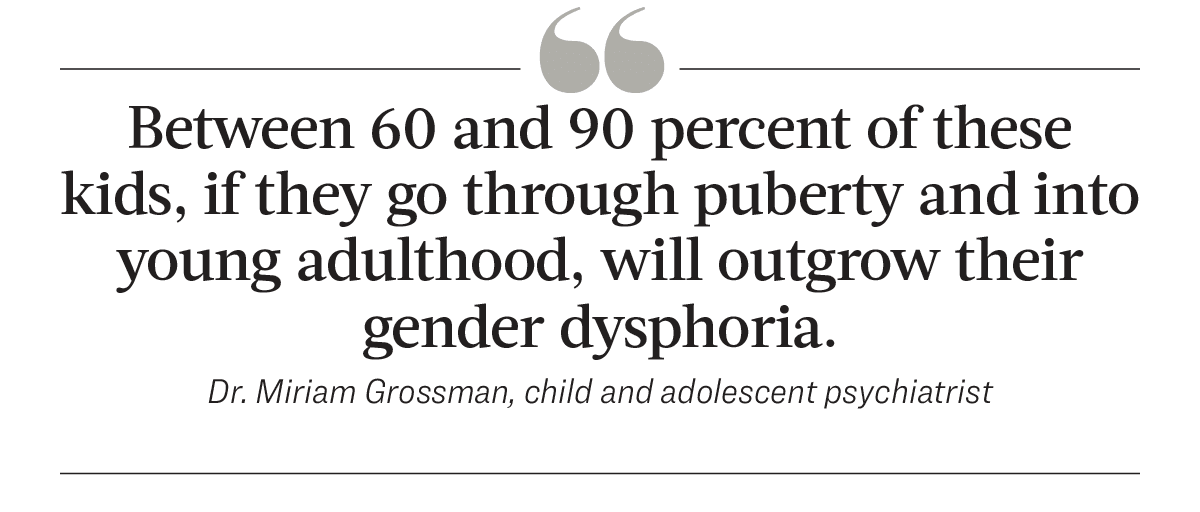It could happen on any given weeknight: While you are enjoying dinner with your family, your teenage daughter suddenly announces that she was born in the wrong body, that you have to start calling her by a male name, and that she wants to start taking cross-sex hormones. And she’s serious about it.
What do you do next?
“It’s very important for the parents to not react in a way that is terribly negative or terribly judgmental, even if they may be feeling at the moment that this is just madness, and this doesn’t make any sense,” advised Dr. Miriam Grossman, a psychiatrist and the author of five books. In her 2009 book “You’re Teaching My Child WHAT?” she warned parents about how sex education has evolved to promote sexual freedom and gender confusion. In her latest book from 2023, “Lost in Trans Nation: A Child Psychiatrist’s Guide Out of the Madness,” she wrote about the damage that the so-called “gender-affirming care” is inflicting on our youth.
Although there’s no one-size-fits-all guide to navigating this scenario, there are some main points to consider.
The Basics
First of all, you know for a fact that your daughter is female, or that your son is male, and that can’t be changed. You are right. Your child is deeply confused and probably brainwashed. You know you must be there for him or her, to bring them back to reality.
It’s important to note that gender dysphoria does exist and has been diagnosed for decades, but it’s extremely rare, occurring in adults at a rate of between 2 and 14 per 100,000 people (between 0.002 and 0.014 percent). In the case of minors, it is so rare that the information is scant and not reliable.
The current wave of young people claiming they were born in the wrong body is a different phenomenon, mostly ideologically and socially constructed. The vast majority of these children are influenced by social media, their school or college, their friends, or a combination of all of the above.
A study on adolescent gender dysphoria found that more than 86 percent of parents reported that their child started to identify as a different gender after binging on social media, having one or multiple friends come out as trans in quick succession, or both.
External influences aren’t the only factors. “These kids are generally those who are vulnerable,“ Dr. Grossman explained. ”They probably have other disorders. A lot of them are on the autism spectrum, they might have anxiety or depression, they may have gone through some difficult trauma, [and] they may have been molested, or abused.”

The link between transgender identities and autism spectrum disorder is undeniable, Dr. Grossman wrote in her book. “People with autism often feel different, misunderstood, and isolated. Their thought patterns and non-conformity likely predispose them to recruitment.”
Diagnoses of ADHD, depression, anxiety, PTSD, and serious eating disorders are also common among these teens and young adults.
The good news is that more and more parents are helping their children to successfully navigate gender confusion, according to Dr. Grossman’s observations.
Reconnecting With Your Child
One of your most important goals should be to rebuild the relationship with your child, and to take the reins as a parent, so she can grow closer to you and away from the negative influences.
Addressing the underlying issue is equally critical. Her intention to change her body, name, and identity is a symptom that there’s something she is running away from or trying to avoid.
“The child is coming to the parent because they have some confusion or some distress. And that’s why the parent has to be focused on hearing, listening, asking questions, and learning more about what the child is actually saying,” Dr. Grossman said.
The process of getting the child out of his or her gender confusion can be long, taking anywhere from several months to a few years.

“You want to let your child know that you recognize that they are going through something, and that it’s something important to them, and it’s something serious, and you’re going to learn as much as you can about it,” Dr. Grossman said. “Come across in a loving way, and a supportive way, without actually agreeing with what your child is saying—that they are the opposite sex, or that you’re going to use the new name and the new pronouns.”
That’s an important point: getting your child to agree to disagree. Kids are being led to believe—on social media, in “affirming” schools, by friends, and even by some therapists and doctors—that the adults in their lives, their parents and others, who do not immediately agree and go along with their “gender identity” are not being supportive.
“It’s important for the child and the adult to understand that you can have a loving relationship even if there are big disagreements,” Dr. Grossman said. “You want this to be a time that your child walks away from the conversation feeling, ‘Well, they didn’t agree with me. They’re not giving me what I want right now, but they also didn’t reject me. They want to understand and learn more.’”
January’s Daughter
In the spring of 2020, January Littlejohn’s teenage daughter told her parents that she didn’t feel like a girl—before being socially “transitioned” at her Florida middle school behind her parents’ backs. She was 13.

Since then, her daughter has backed out of the trans identification, and now “feels comfortable as a girl,” Ms. Littlejohn said. Now Ms. Littlejohn devotes her time to helping other parents going through similar situations. She’s an advocate for Do No Harm, an organization focused on raising awareness about the dangers of identity politics in medical practice.
She describes what families go through when dealing with a gender-confused child as “a power struggle.” In her case, it was not only with her own daughter, but with the school as well.
“They essentially sent a very clear message to her that our parental authority was no longer respected or needed. And that created a huge wedge in our relationship with our daughter, because in her mind, we were the only ones in her life not affirming. But in reality, we were the only ones in her life keeping her tethered to reality and trying to protect her from this pathway. She was ultimately being led directly to medical harm,” Ms. Littlejohn said.
Avoiding medical procedures that supposedly help with “gender transition” is a key issue. A growing number of studies and medical doctors warn about the dangers of cross-sex hormones, puberty blockers, and surgeries. In her book, Dr. Grossman explains in detail how the “science” behind those treatments has been debunked. She recommends parents learn about these procedures’ risks and share them with their children.
Again, each family is different, and parents have to figure out the best way to approach the issue.
“Even though my daughter was talking about surgical procedures and things of that nature, we set very clear, healthy boundaries with her, in terms of allowing her to wear her hair how she wanted—within an appropriate, reasonable way,” Ms. Littlejohn said. “So no medical interventions. We talked to our daughter about brain development, and we got her to agree to no physical intervention until she was 25 to 27, when she would be both financially independent and her brain fully developed.”
The Importance of Puberty
Dr. Grossman dedicates a whole section of her book to explaining how critical puberty is for the development of the body and how the brain doesn’t reach full development until well into the third decade of life.
“Puberty is something that we want kids to go through,” Dr. Grossman said. “[It’s] the most important developmental process that kids need to go through, outside of the development that they went through before they were born. Puberty affects every system in the body. The exposure of the brain to the hormones of puberty causes the brain over the years to mature.
“When we give puberty blockers to kids ... we delay their natural puberty, that natural stage of development. We have no idea what the long-term effects [will be].”
Puberty is a complex process of change. Anyone who has gone through puberty and adolescence knows how confusing and frustrating these changes are.
“It’s a very awkward, uncomfortable experience,” said Ms. Littlejohn, who is also a licensed mental health counselor. “But instead of being told, ‘This is normal, you’re gonna get through it. It’s going to be OK, we all felt the same,’ a lot of these kids are being told and conditioned to believe, ‘If you feel discomfort, it’s because you’re probably trans.’”
The brain matures during puberty, allowing for a fully grown prefrontal cortex to rationally weigh actions and their consequences. The amygdala also develops, bringing emotional balance to the mix. It’s not surprising, then, that many kids grow out of their gender confusion after going through puberty.
“Between 60 and 90 percent of these kids, if they go through puberty and into young adulthood, will outgrow their gender dysphoria,” Dr. Grossman said.

That’s why she advocates for a watchful waiting approach. “Watchful waiting means you give them support with their feelings, you give the family support, and you might allow certain behaviors or ways of dressing. But you do not socially transition them the way it is being done now,” she said.
Is Therapy a Good Idea?
Even though therapy can be helpful in some cases, both Dr. Grossman and Ms. Littlejohn advised caution when choosing a therapist for your child.
“Not every child needs therapy,” Dr. Grossman said. “If the family does feel that they need therapy, they do not want to go to someone who calls themselves a ‘gender-affirming’ therapist.
”That therapist is going to immediately accept the new identity, and is going to tell the parents that they must accept the new identity.”
Some professionals take the watchful waiting approach and dig into the underlying issues. Therapy First is an organization with nonaffirming therapists who work with both the parents and the children.
Taking Back the Reins as a Parent
“It’s really important for parents to understand that you are the expert of your child; you cannot rely on someone else to pull your child out of this,” Ms. Littlejohn said. “The parents have to be willing to exert their parental authority. And I don’t mean in a very authoritarian, restrictive, controlling way. I mean approaching this issue from a place of love and compassion for your child.”
Even though the specifics depend on each situation, Ms. Littlejohn shared the following four common steps that she and other parents have taken in order to help their children.
- Restrict internet usage. Much of the influence on your child comes from the internet. Negative influences come from social media, online message boards, and online community websites. People grooming children online tell them about transgenderism and encourage them to hide it from their parents. Some parents choose to cut their children’s access to the internet completely; some take their children’s phones away. Several tools, such as content filtering apps, can help parents restrict what their children can do online.

- Spend quality time together. To reconnect with your child, plan activities together. Cooking, camping, hiking, and watching family-oriented movies are some options. The goal is to strengthen the emotional bond with your child so that he or she trusts you and values your opinion.

- Have open conversations with your child. Get him to talk about how he is feeling, but don’t pressure him on the gender issue, as that will make him less open to a different opinion. “You can start to plant the seeds and ask them things that are going to get them critically thinking about this ideology, because it’s riddled with contradictions,” said Ms. Littlejohn. For example, if gender is fluid and can change at any time, why would you make permanent changes to your body? “I started asking questions from a place of curiosity, just asking my daughter questions, listening, not giving judgment. Just getting her to critically think about some of the contradictions without telling her the contradiction,” she said.
- Take preventive measures. Before this issue gets into your home, you can—in Ms. Littlejohn’s words—“inoculate” your kids against the transgender ideology. Talk to them about the realities of biology—that there are only two sexes and whoever says otherwise is lying to them or deeply confused. You should also warn them about other people telling them to keep secrets from their parents so that they will instead immediately let you know about it. And similar to when you explain to them that nobody should touch their private parts, you can let them know that no adult should ask them their pronouns or talk about gender and sex with them. Those should all be red flags that your child is aware of.
The ‘Nuclear’ Options
In more extreme cases, some parents have needed to take drastic measures.
“Parents have to realize this is a radical ideology. It often takes radical steps to get your child out of this,” Ms. Littlejohn said. “I did not fully understand that in the beginning, but I am 100 percent convinced now.”
Some parents have removed their children from the schools where they were being socially transitioned. Some have moved to states where parental rights are stronger.
Dr. Grossman called these “nuclear options” and said that they make parents feel stronger and more confident. They also help the child see the extent their parents are willing to go to help them. Hopefully, they’ll appreciate it.
“The [parents who are] willing to fight for their kids and be creative in their parenting, those are the ones that are finding success,” Ms. Littlejohn said.
Dealing with this kind of situation at home can take a toll on parents’ physical and mental health. Nowadays, there are many support groups for parents. The grief and trauma parents suffer are usually overlooked by parents themselves and society as a whole. This topic will be explored in an upcoming article.












